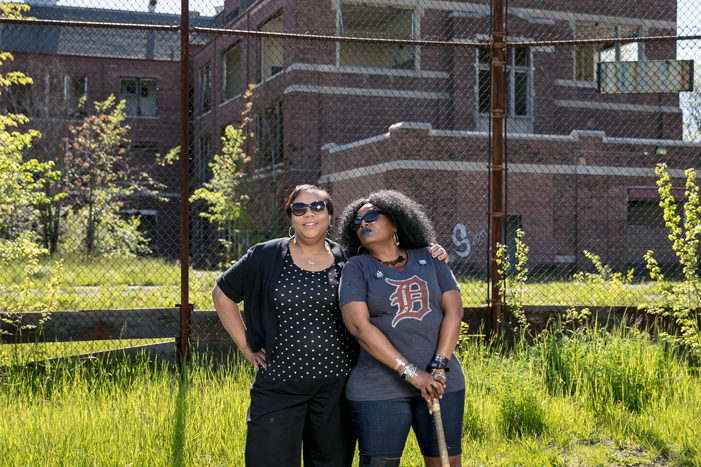Ground zero for the 1967 civil disturbance is becoming ground zero for neighborhood transformation, thanks to involved citizens and the Detroit Planning and Development Department. A standing-room-only crowd recently sought a hundred ways to preserve historical buildings and increase the density of homes and retail.
With the renovation of Herman Kiefer Hospital in the works and the city’s $1.6 million in planning and design for the Rosa Parks/Clairmount neighborhood and three other target communities, the wish list has a real chance of being fulfilled and sustained.
Most vocal among concerns, residents want to restore Hutchins Park so neighborhood kids can play baseball and elders can play checkers under shade trees. They ask for streets safe enough that children can walk to the park, and they want abandoned buildings like Hutchins School to be renovated.

“When I was a kid we had four baseball diamonds,” says Renee “Nee-nee” Gunn. “I played softball almost every morning. I kissed boys in the cubby hole. Now I’m fighting to bring the life back to this neighborhood so kids can run, breathe and play – not smoke weed in their basements, staring at PlayStation all day, every day.”
Gunn is the first official storyteller in a series of neighborhood conversations that will happen monthly in this south-central sector of Detroit. The Rosa Parks/Clairmount Community forum at Joseph Walker Williams Recreation Center brought together both long-time and newer residents of the neighborhood. Citizens met with city officials and representatives of Chicago-based Gensler Consulting, led by Andre Broomfield.
Agencies, historical societies and film producers are training their attention on the west-side community in the shadow of Motown Museum, an area that witnessed one of the nation’s largest civil disturbances during five days in the summer of 1967. In the ensuing years most of the shops disappeared, schools were shuttered and numerous homes fell to neglect. Out of the ashes, a determined community has emerged and wants to be known.
“To keep young adults here, to give them a chance, we need safety and security, education in career opportunities, destinations people can walk to,” Broomfield says. His vision includes murals on buildings, renovation of historic houses, new construction, scales of open space and families strolling with baby carriages and pets.

Broomfield’s polling of residents found 63 percent in favor of redeveloping Herman Kiefer, a $143 million investment that could become a small hotel and indoor skate park. The investor, New York-based Ron Castellano, has spent numerous hours with residents. As part of the project, he also takes on maintenance of 300 empty lots and 100 vacant homes near Hamilton, Taylor and Pingree.
Mildred Robbins stood to praise Castellano for listening and involving neighbors in the vision.
“They will help us build a more solid community,” she told the audience. Others called the development a pipeline for job-seekers.
Some residents expressed concern their hopes for the area would fall apart in a few years, as past projects have. The Farmer Jack Plaza in the neighborhood then called Virginia Park was built after the ‘67 rebellion and lasted only a decade before being shuttered. But the nearby townhouses and subdivision built in the 1980’s and 1990’s look well-maintained and occupied.
“We’re bringing ideas to the table that never were thought of before,” says Vince Keenan, District 5 manager. “Together we will create entities that breathe and evolve with time. The community engagement process helps assure our ideas are sustainable.”
Sharon Calmese, who lives with her children and husband Frank, is optimistic. She is an active block club member whose roots in Rosa Parks/Clairmount date back to her father, who raised seven children.
“I want this neighborhood to come back for my children,” Calmese says.
Violence isn’t a daily problem, but certain events sting her soul. Her 11-year-old grandson had just come in from playing basketball in the neighborhood when a car full of young men shot up another car on the street. One man died.
One participant in the forum hoped Rosa Parks Boulevard would be known again as 12th Street because, beyond the five days in July 1967, it represented a thriving retail community and destination for much of Detroit. Others remain in favor of honoring the civil rights champion, who was a one-time resident of the area, by maintaining her name.
Planning and Development hopes to address security needs by providing increased public safety, getting help from the Detroit Land Bank to demolish some structures, and boarding vacant school buildings.
“I want it to flourish,” Calmese says, “so children can go outside and play.”


